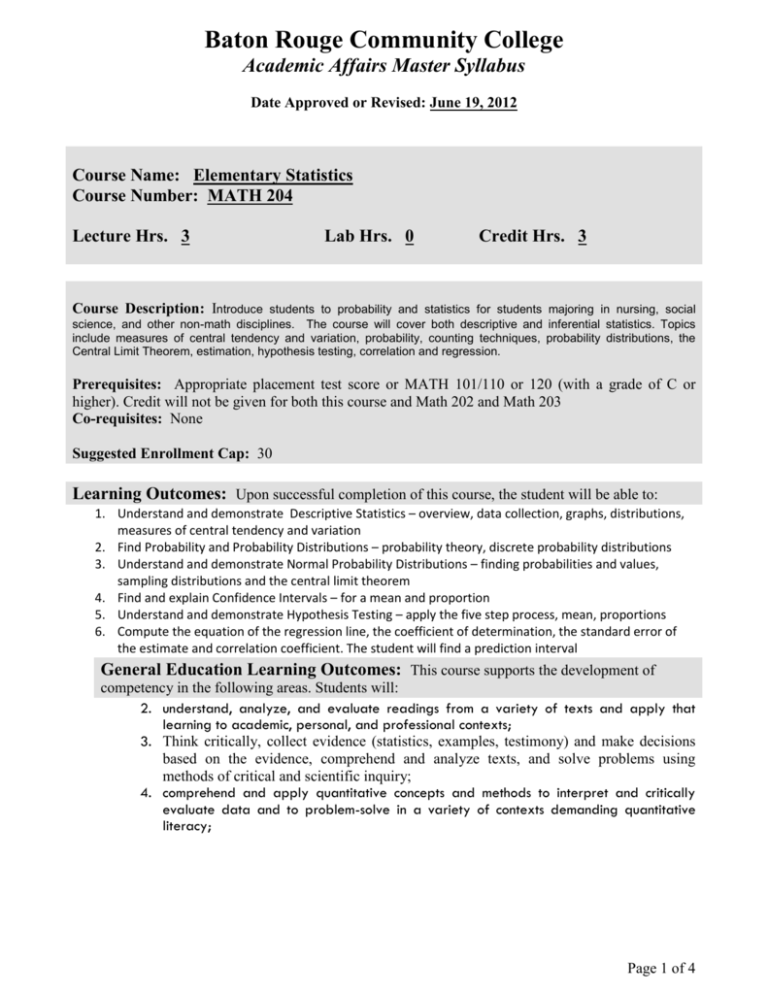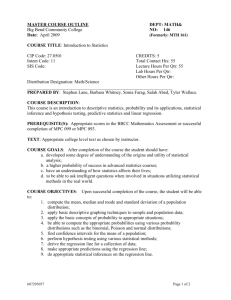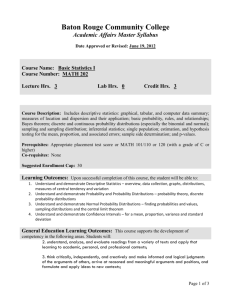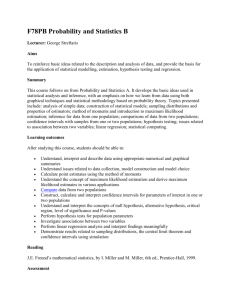MATH 204 - Baton Rouge Community College
advertisement

Baton Rouge Community College Academic Affairs Master Syllabus Date Approved or Revised: June 19, 2012 Course Name: Elementary Statistics Course Number: MATH 204 Lecture Hrs. 3 Lab Hrs. 0 Credit Hrs. 3 Course Description: Introduce students to probability and statistics for students majoring in nursing, social science, and other non-math disciplines. The course will cover both descriptive and inferential statistics. Topics include measures of central tendency and variation, probability, counting techniques, probability distributions, the Central Limit Theorem, estimation, hypothesis testing, correlation and regression. Prerequisites: Appropriate placement test score or MATH 101/110 or 120 (with a grade of C or higher). Credit will not be given for both this course and Math 202 and Math 203 Co-requisites: None Suggested Enrollment Cap: 30 Learning Outcomes: Upon successful completion of this course, the student will be able to: 1. Understand and demonstrate Descriptive Statistics – overview, data collection, graphs, distributions, measures of central tendency and variation 2. Find Probability and Probability Distributions – probability theory, discrete probability distributions 3. Understand and demonstrate Normal Probability Distributions – finding probabilities and values, sampling distributions and the central limit theorem 4. Find and explain Confidence Intervals – for a mean and proportion 5. Understand and demonstrate Hypothesis Testing – apply the five step process, mean, proportions 6. Compute the equation of the regression line, the coefficient of determination, the standard error of the estimate and correlation coefficient. The student will find a prediction interval General Education Learning Outcomes: This course supports the development of competency in the following areas. Students will: 2. understand, analyze, and evaluate readings from a variety of texts and apply that learning to academic, personal, and professional contexts; 3. Think critically, collect evidence (statistics, examples, testimony) and make decisions based on the evidence, comprehend and analyze texts, and solve problems using methods of critical and scientific inquiry; 4. comprehend and apply quantitative concepts and methods to interpret and critically evaluate data and to problem-solve in a variety of contexts demanding quantitative literacy; Page 1 of 4 Assessment Measures: A comprehensive final exam; and Instructor created exams and or homework. Information to be included on the Instructors’ Course Syllabi: Disability Statement: Baton Rouge Community College seeks to meet the needs of its students in many ways. See the Office of Disability Services to receive suggestions for disability statements that should be included in each syllabus. Grading: The College grading policy should be included in the course syllabus. Any special practices should also go here. This should include the instructor’s and/or the department’s policy for make-up work. For example in a speech course, “Speeches not given on due date will receive no grade higher than a sixty” or “Make-up work will not be accepted after the last day of class.” Attendance Policy: Include the overall attendance policy of the college. Instructors may want to add additional information in individual syllabi to meet the needs of their courses. General Policies: Instructors’ policy on the use of things such as beepers and cell phones and/or hand held programmable calculators should be covered in this section. Cheating and Plagiarism: This must be included in all syllabi and should include the penalties for incidents in a given class. Students should have a clear idea of what constitutes cheating in a given course. Safety Concerns: In some programs this may be a major issue. For example, “No student will be allowed in the safety lab without safety glasses.” General statements such as, “Items that may be harmful to one’s self or others should not be brought to class.” Library/ Learning Resources: Since the development of the total person is part of our mission, assignments in the library and/or the Learning Resources Center should be included to assist students in enhancing skills and in using resources. Students should be encouraged to use the library for reading enjoyment as part of lifelong learning. Expanded Course Outline I. Introduction to Statistics: 1. An Overview of Statistics 2. Data Classification 3. Experimental Design II. Descriptive Statistics: 1. Frequency Distributions and Their Graphs 2. Measures of Center Tendency 3. Measures of Variation III. Probability: 1. Basic Concepts of Probability and Page 2 of 4 Counting 2. Conditional Probability and the Multiplication Rule 3. Addition Rule IV. Probability Distributions: 1. Probability Distributions 2. Binomial Probability Distributions V. Normal Probability Distributions: 1. Introduction to Normal Distribution and Standard Normal Distribution 2. Normal Distributions: Finding Probabilities 3. Normal Distributions: Finding Values 4. Sampling Distributions and The Central Limit Theorem VI. Confidence intervals: 1. Confidence Intervals for Mean (Large Samples) 2. Confidence Intervals for Mean (Small Samples) 3. Estimating a Population Proportion VII. Hypothesis Testing: 1. Introduction of Hypothesis Testing 2. Hypothesis Testing for the Mean (large Samples) 3. Hypothesis Testing for the Mean (Small Samples) 4. Hypothesis Testing for Proportions VIII. Correlation and Regression: 1. Correlation 2. Regression Page 3 of 4 Proposed Course Outline Tentative Lecture Week #1 Week #2 Week #3 Week #4 Week #5 Week #6 Week #7 Week #8 Week #9 Week #10 Week #11 Week #12 Week #13 Week #14 Week #15 Topics Homework Assignments Introduction to Statistics: 1-1 An Overview of Statistics 1-2 Data Classification 1-3 Experimental Design Descriptive Statistics: 2-1 Frequency Distributions and Their Graphs 2-3 Measures of Center Tendency 2-4 Measures of Variation Probability: 3-1 Basic Concepts of Probability and Counting 3-2 Conditional Probability and the Multiplication Rule 3-3 Addition Rule Probability Distributions: 4-1 Probability Distributions 4-2 Binomial Probability Distributions Normal Probability Distributions: 5-1 Introduction to Normal Distribution and Standard Normal Distribution 5-2 Normal Distributions: Finding Probabilities 5-3 Normal Distributions: Finding Values 5-4 Sampling Distributions and The Central Limit Theorem Confidence intervals: 6-1 Confidence Intervals for Mean (Large Samples) 6-2 Confidence Intervals for Mean (Small Samples) 6-3 Estimating a Population Proportion Hypothesis Testing: 7-1 Introduction of Hypothesis Testing 7-2 Hypothesis Testing for the Mean (large Samples) 7-3 Hypothesis Testing for the Mean (Small Samples) 7-4 Hypothesis Testing for Proportions Correlation and Regression: 9-1 Correlation 9-2 Regression Review Review Page 4 of 4







